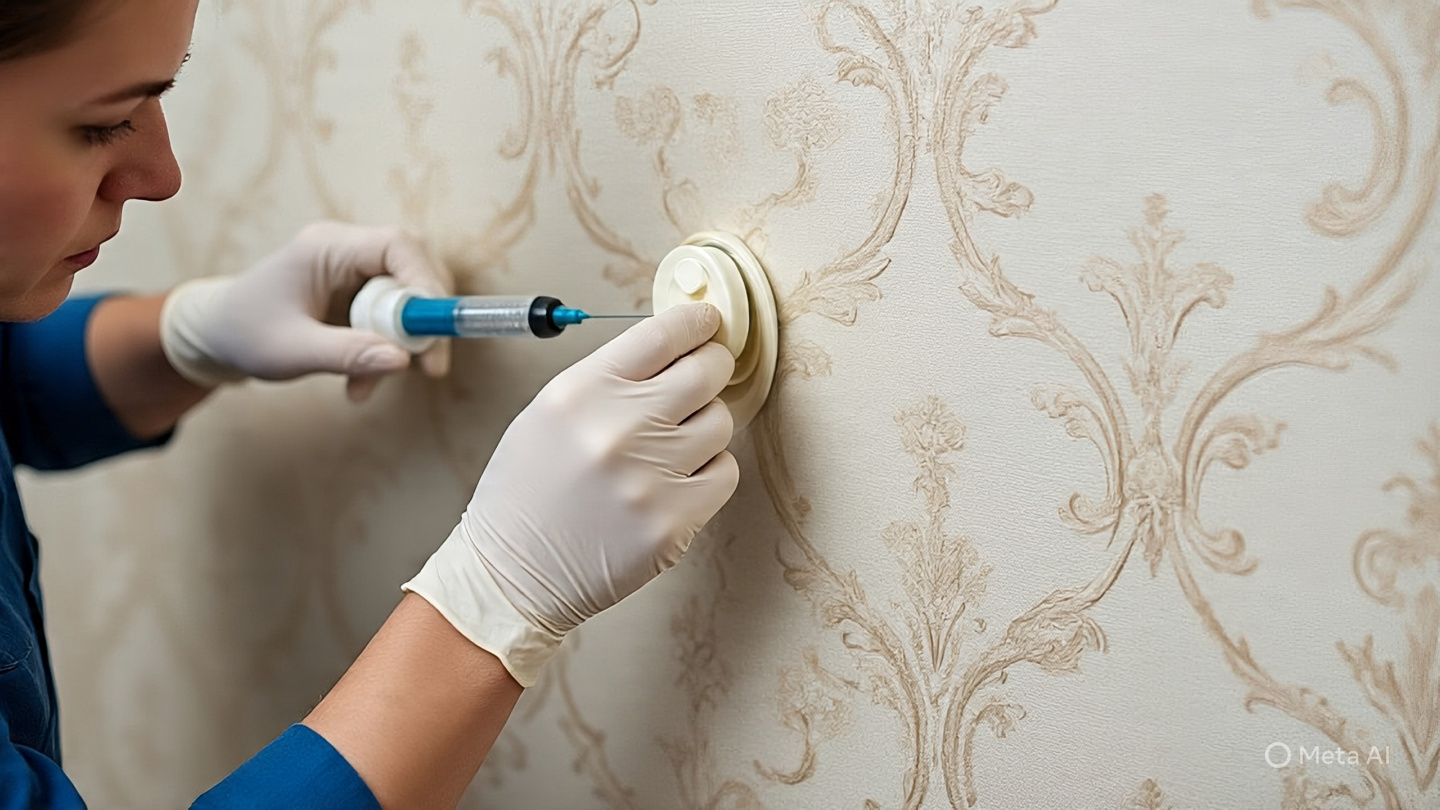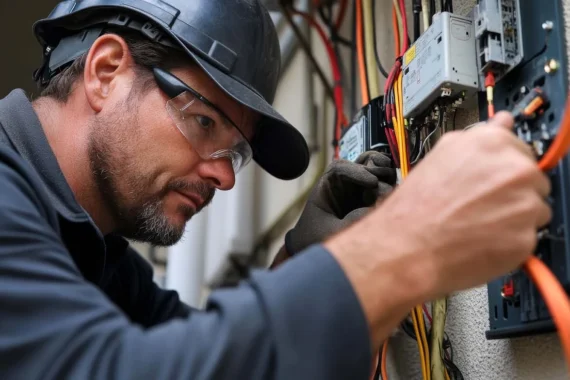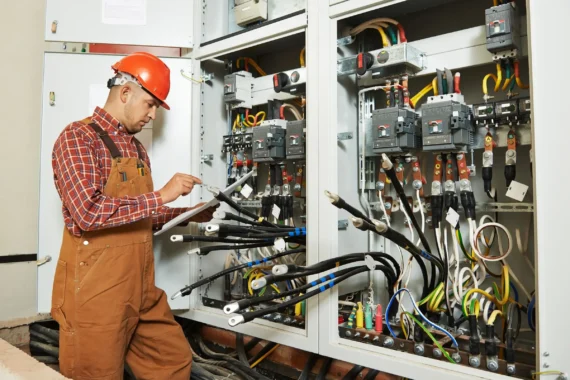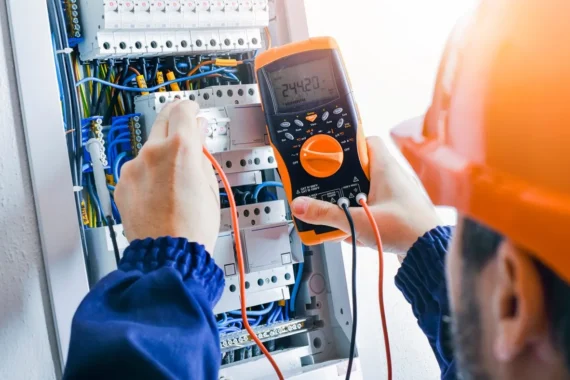Imagine your perfectly decorated home or office in Dubai, adorned with stunning wallpaper that truly enhances the ambiance. Then, one day, you spot the air bubbles on the smooth surface, dimming the aesthetic appeal. You need to fix wallpaper bubbles for an elegant look. This is a common frustration for property owners and tenants across the emirate. But why do they appear, especially in Dubai’s unique environment?
This comprehensive guide will tell you the origins of wallpaper bubbles in Dubai’s buildings, help you with practical DIY solutions for minor issues, and help you determine when it’s time to call in the professionals. Our goal is to equip you with the knowledge to maintain flawless walls, ensuring your wallpaper projects stand the test of time and climate.
The Culprits Behind Wallpaper Bubbles in Dubai’s Buildings
Understanding the “why” is crucial for both prevention and effective repair. In Dubai, several factors, some unique to its climate, contribute to wallpaper bubbles:
- Dubai’s Dynamic Climate: Heat and Humidity
- Adhesive Weakening: The city’s intense heat and fluctuating humidity levels are primary antagonists. Over time, wallpaper adhesives can degrade or react to these conditions, losing their grip and allowing the paper to lift.
- Expansion and Contraction: Wallpaper materials themselves, and the walls beneath them, can subtly expand and contract with temperature and humidity shifts. This movement puts stress on the adhesive bond, leading to bubbles or wrinkles. This is often why bubbles might appear gradually or after seasonal changes.
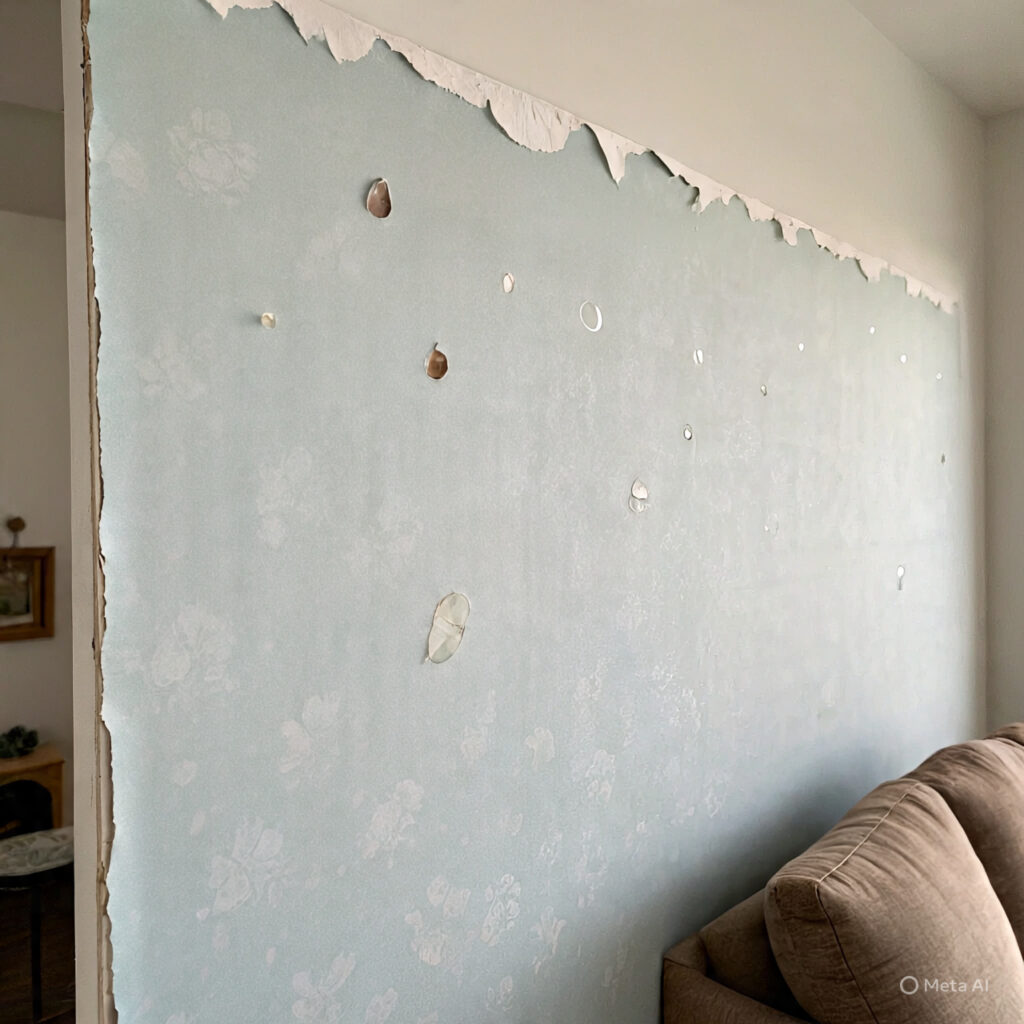
- Improper Wall Preparation: The Foundation of Failure
- Dirty or Uneven Surfaces: Any dust, grease, old paint flakes, or uneven plaster on the wall will prevent the wallpaper adhesive from bonding uniformly. This creates air pockets where bubbles are guaranteed to form.
- Unprimed or Incompatible Priming: Highly porous surfaces like unprimed drywall can absorb the wallpaper paste too rapidly, diminishing its bonding power. Conversely, using a primer incompatible with the adhesive or wallpaper material can also lead to adhesion failure and bubbling as the glue dries.
- Moisture Seepage or Dampness: This is a more severe underlying issue. If moisture is seeping through the walls (e.g., from leaks, poor waterproofing), it will inevitably weaken the adhesive, cause the wallpaper to bubble and peel, and potentially lead to mold growth.
- Adhesive Application Errors: A Sticky Situation
- Too Much or Too Little Paste: Applying an excessive amount of adhesive can create “wet bubbles” that remain even after smoothing, as there’s simply too much material to bond tightly. Conversely, insufficient paste results in “dry bubbles” due to inadequate contact and poor adhesion.
- Uneven Paste Distribution: If the adhesive isn’t spread uniformly across the wallpaper or wall, some areas will adhere perfectly while others remain loose, forming bubbles.
- Incorrect Adhesive Type: Using a standard wallpaper paste not specifically formulated for high-humidity, high-temperature environments like Dubai can lead to premature bubbling and peeling. Heavy-duty, mold-resistant, or “tropical formula” adhesives are often recommended here.
- Trapped Air During Installation:
- Even with perfect wall preparation and adhesive, air can inadvertently get caught between the wallpaper and the wall if the paper isn’t meticulously smoothed out from the center outwards during hanging. This is particularly common with larger panels or textured wallpapers, where air can become easily trapped.
- Insufficient “Booking” Time:
- For certain wallpaper types (especially traditional paper-backed designs), “booking” involves folding pasted sections back on themselves for a specified period. This allows the paper to fully absorb the adhesive and expand uniformly before being applied to the wall. Skipping this crucial step can cause the paper to expand unevenly on the wall, leading to bubbles.
- Material Quality:
- While less common with reputable suppliers in Dubai, using low-quality wallpaper or adhesive not designed for durability can result in materials that simply don’t withstand the local climate or typical wear and tear, eventually leading to bubbling.
DIY Solutions: How to Get Rid of Air Bubbles in Wallpaper in Dubai
For minor to moderate wallpaper bubbles, a hands-on DIY approach can often provide a quick and effective fix. Acting promptly can prevent small bubbles from growing into larger, more problematic areas. Some experts practically give the details of removing it.
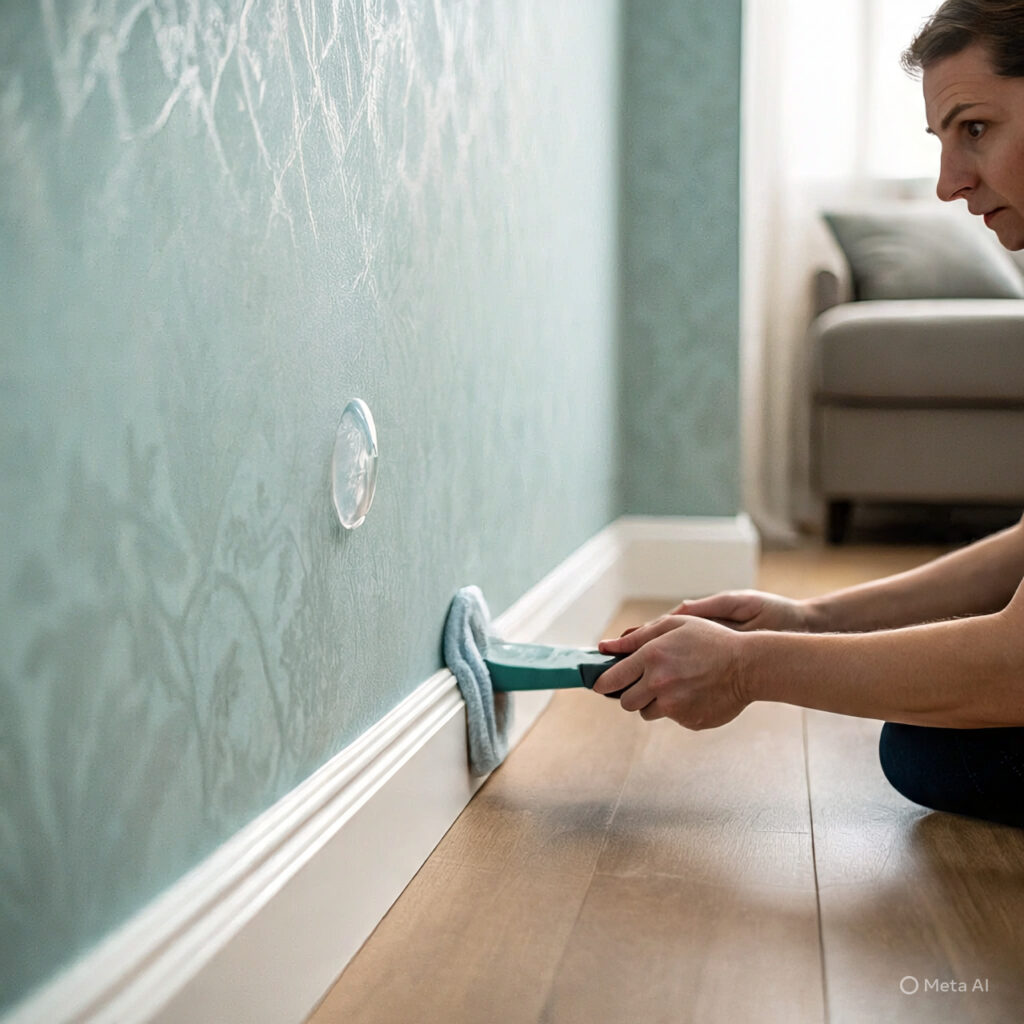
Essential Tools You’ll Need:
- Razor-Sharp Utility Knife or Snap-Blade Knife: Crucial for precise, clean cuts without tearing. Always use a brand-new blade.
- Wallpaper Pasting Syringe: This specialized tool, often found at hardware stores like ACE Hardware, is ideal for injecting adhesive precisely.
- Wallpaper Smoothing Tool: A plastic smoother, seam roller, or a soft-foamed tool designed for wallpaper will help you flatten bubbles without damaging the surface.
- Appropriate Wallpaper Paste/Adhesive: Ensure it’s suitable for your wallpaper type and ideally formulated for high-humidity conditions (e.g., heavy-duty, heat-resistant options available in Dubai).
- Clean, Damp Sponge or Cloth: For wiping away excess adhesive.
- Fine Needle or Pin: For very small bubbles.
Step-by-Step DIY Repair Guide:
- Locate and Assess the Bubble:
- Carefully run your hand over the wallpaper surface to identify all bubbled areas.
- Gently press on each bubble to determine its nature:
- Wet Bubble: Feels soft and squishy, often indicating too much paste or trapped moisture (more common with recently hung wallpaper).
- Dry Bubble: Feels firm and empty, usually due to trapped air or insufficient adhesive. Bubbles can also hide small pieces of debris like paint chips or dust.
- For Small, Wet Bubbles (Newly Hung Wallpaper):
- If the wallpaper was recently hung and the adhesive is still moist, you might simply be able to gently smooth the bubble outwards towards the nearest edge using your smoothing tool. Excess adhesive will squeeze out; immediately wipe it clean with a damp sponge.
- For Small, Dry Bubbles (The Pinprick Method):
- For small, isolated dry bubbles, take a very fine needle or pin and carefully prick a tiny hole (or several, if needed) in the center of the bubble.
- Gently press the air out, working from the edges of the bubble towards the pinprick.
- If the bubble flattens completely and stays, you’re done. If it lifts again, it needs more adhesive. Proceed to the next step.
- For Larger Bubbles (The “X” Cut and Inject Method):
- Make the Incision: Very carefully make a small “X”-shaped incision over the center of the bubble using your sharp utility knife. Aim to align the cut with the wallpaper pattern if possible to minimize its visibility. Ensure the incision opens up the entire bubbled area without cutting too deeply into the wall beneath.
- Inspect and Clean: Gently lift the flaps of the “X” cut. Inspect for any trapped debris, dust, or old paint chips that might be causing the bubble. Carefully remove any particles. If the bubble was caused by excess paste, gently squeeze out the surplus and smooth the area.
- Inject Adhesive: Fill your wallpaper adhesive syringe with the appropriate paste. Carefully insert the tip of the syringe into the opening of the “X” cut. Slowly and evenly inject the adhesive underneath the wallpaper, ensuring you cover the entire bubbled area. Avoid over-saturating the paper or pushing the syringe too far, which could tear properly adhered sections.
- Smooth and Flatten: Using your wallpaper smoothing tool, apply light, even pressure and work outwards from the center of the bubble towards the “X” cut and the edges. This will push out any trapped air and excess adhesive, ensuring the wallpaper lies flat and the cut edges bond seamlessly.
- Wipe Away Excess: Immediately use a clean, damp sponge or cloth to wipe away any adhesive that oozes out onto the wallpaper surface. Ensure the repaired area remains flat and intact after cleaning.
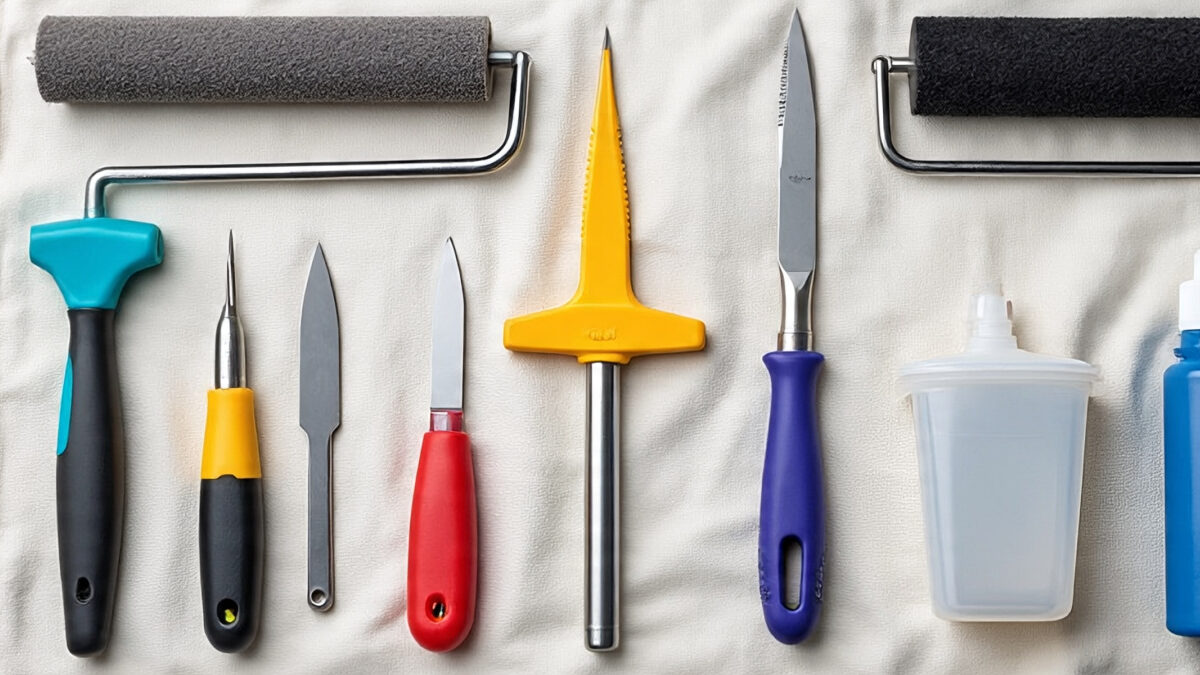
Crucial Tips for DIY Success in Dubai’s Environment:
- Work Efficiently: Adhesives can dry faster in Dubai’s heat. Be prepared and work with purpose once you start.
- Optimal Drying Conditions: Ensure good ventilation in the room while the adhesive dries, but avoid strong, direct drafts from AC units or open windows that could cause uneven drying or premature lifting.
- Patience is Key: Allow the repaired area ample time to dry and cure completely before assessing the final result. Some minor irregularities may disappear as the adhesive sets and tightens.
- Test if unsure: If using a new adhesive or technique, consider testing it on a small, inconspicuous area or a leftover piece of wallpaper first.
- Consider a hairdryer (with caution): Some sources suggest gently warming the area with a hairdryer on a low setting after smoothing to aid drying, but use extreme caution to avoid overheating or shrinking the wallpaper.
DIY Wallpaper Bubble Repair vs. Professional Service in Dubai: Making the Right Choice
The decision to tackle wallpaper bubbles yourself or to enlist professional help in Dubai hinges on several factors: the extent of the damage, your confidence in DIY, the type of wallpaper, and your desired outcome.
Advantages of DIY Repair:
- Cost-Effective: For small, isolated bubbles, DIY is significantly more budget-friendly, as your main expenses are tools and a small amount of adhesive.
- Immediate Solution: You can address the problem as soon as it’s noticed, potentially preventing it from worsening.
- Personal Satisfaction: Successfully fixing an issue yourself can be a rewarding experience.
Disadvantages of DIY Repair:
- Risk of Further Damage: Incorrect techniques, using the wrong tools, or improper adhesive application can inadvertently tear the wallpaper, cause discoloration, or lead to even larger bubbles.
- May Not Address Underlying Causes: If the bubbles are due to serious issues like persistent moisture seepage or fundamentally poor wall preparation that you can’t identify or rectify, the problem will likely recur.
- Time-Consuming for Extensive Damage: Dealing with widespread bubbling can be a tedious and lengthy process, especially for someone without experience.
- Suboptimal Finish: Achieving a perfectly seamless, professional-looking repair can be challenging for an amateur, particularly on intricate patterns or highly visible walls.
When to Hire a Professional Wallpaper Repair Service in Dubai:
For peace of mind and a guaranteed flawless finish, a professional service is often the best choice in the following scenarios:
- Extensive or Widespread Bubbling: If a significant portion of your wallpaper is affected, or if multiple large bubbles are present, professional intervention ensures a consistent and durable repair across the entire area.
- High-End, Delicate, or Custom Wallpaper: Expensive, intricate, or uniquely textured wallpapers (like some embossed or silk designs) are prone to irreversible damage during DIY attempts. Professionals have the specialized tools, techniques, and experience to handle such materials with care.
- Suspected Underlying Wall Issues: If the bubbles are a symptom of deeper problems like recurrent moisture, efflorescence (salt deposits), or severely uneven plaster, a professional can accurately diagnose and rectify these root causes before attempting the wallpaper repair, ensuring a long-term solution.
- Lack of Time, Tools, or Expertise: If you’re pressed for time, don’t have the necessary specialized tools (e.g., specific rollers, steaming equipment for removal), or simply lack confidence in your DIY abilities, a professional service offers convenience and assurance.
- Desire for a Flawless, Undetectable Finish: Professionals possess the skill to make repairs virtually invisible, seamlessly blending the patched area with the existing wallpaper, which is paramount for high-visibility areas.
What to Expect from Professional Wallpaper Services in Dubai:
Reputable wallpaper repair and installation companies in Dubai offer a comprehensive approach:
- Thorough Inspection: They will meticulously examine your walls and wallpaper to precisely identify the cause and extent of the bubbling.
- Expert Surface Preparation: Professionals ensure the wall is meticulously cleaned, smoothed, dried, and properly primed with materials compatible with the climate and wallpaper type.
- Use of Climate-Optimized Materials: They utilize high-quality, specialized adhesives and techniques designed to withstand Dubai’s unique heat and humidity, ensuring longevity.
- Precise Repair and Installation Techniques: Leveraging professional tools and extensive experience, they execute repairs with precision, resulting in smooth, seamlessly integrated finishes.
- Guarantees and Warranties: Many established services provide warranties on their workmanship, offering added peace of mind.
Understanding Professional Wallpaper Repair Costs in Dubai:
The cost of professional wallpaper repair can vary widely. Factors influencing the price include
- Scope of Damage: Small, isolated bubble repairs will naturally be less expensive than rectifying widespread bubbling or reinstalling large sections.
- Wallpaper Type: More delicate, luxurious, or specialized wallpapers may incur higher costs due to the increased care and expertise required.
- Underlying Wall Issues: If the repair necessitates extensive wall preparation (e.g., plastering, moisture treatment, mold remediation), this will add significantly to the overall expense.
- Service Provider: Pricing structures vary between companies. It’s always advisable to obtain detailed, itemized quotes from several reputable providers before making a decision. While a rough estimate for basic wallpaper fixing might range from AED 10 to AED 30 per square foot, extensive repairs or hourly rates (potentially AED 90 – AED 300+ per hour) could apply depending on complexity.
Proactive Prevention: Keeping Wallpaper Bubbles in Dubai
The best fix for wallpaper bubbles is to prevent them from forming in the first place. Especially in Dubai’s climate, these preventative measures are crucial:
- Impeccable Wall Preparation is Non-Negotiable:
- Cleanliness: Ensure walls are spotless, free of dust, grease, and grime.
- Smoothness: Fill any holes, cracks, or uneven textures, then sand the wall smooth. Any bump or imperfection will likely result in a bubble.
- Priming: Always use a high-quality wallpaper primer, especially on new drywall, painted walls, or previously wallpapered surfaces. This seals the surface, promotes better adhesion, and prevents the wall from absorbing the paste too quickly. Opt for primers designed for humid environments.
- Choose High-Quality Materials Suited for Dubai:
- Wallpaper: Invest in durable, high-quality wallpaper materials that are less prone to expansion/contraction and tearing. Some wallpapers are specifically designed for high-humidity areas.
- Adhesive: Do not skimp on wallpaper paste. Select a premium, heavy-duty adhesive that is specifically formulated for high-humidity, high-temperature climates. “Ultra clear” or “extra strength” varieties are often recommended.
- Master Proper Installation Techniques:
- Even Paste Application: Ensure the adhesive is applied uniformly to either the wall or the wallpaper (depending on the type), leaving no dry spots or excessive clumps. Here you have a guide to fix it.
- Thorough Smoothing: As you apply each strip of wallpaper, use a smoothing tool (plastic or rubber roller) to meticulously press out all air bubbles, working from the center of the strip outwards towards the edges. This is perhaps the most critical step during installation.
- Adequate “Booking” Time: If your wallpaper type requires booking, adhere to the manufacturer’s recommended time to allow the paper to fully expand before application.
- Manage Indoor Climate:
- While you can’t control Dubai’s outdoor climate, maintaining a consistent, moderate indoor temperature and humidity level (e.g., through proper air conditioning and dehumidification) can help reduce stress on wallpaper adhesives over time.
Conclusion: Ensuring Lasting Beauty for Your Dubai Walls
Wallpaper bubbles can be an annoying setback, but they are often manageable with the right approach. By understanding the specific challenges posed by Dubai’s climate, combined with meticulous wall preparation and proper installation techniques, you can significantly reduce their occurrence. For minor issues, a confident DIY repair can save the day. However, for extensive damage, valuable wallpaper, or persistent underlying problems, entrusting the task to a professional wallpaper service in Dubai will ensure a flawless, long-lasting finish, allowing your walls to remain a stunning feature of your property for years to come.

